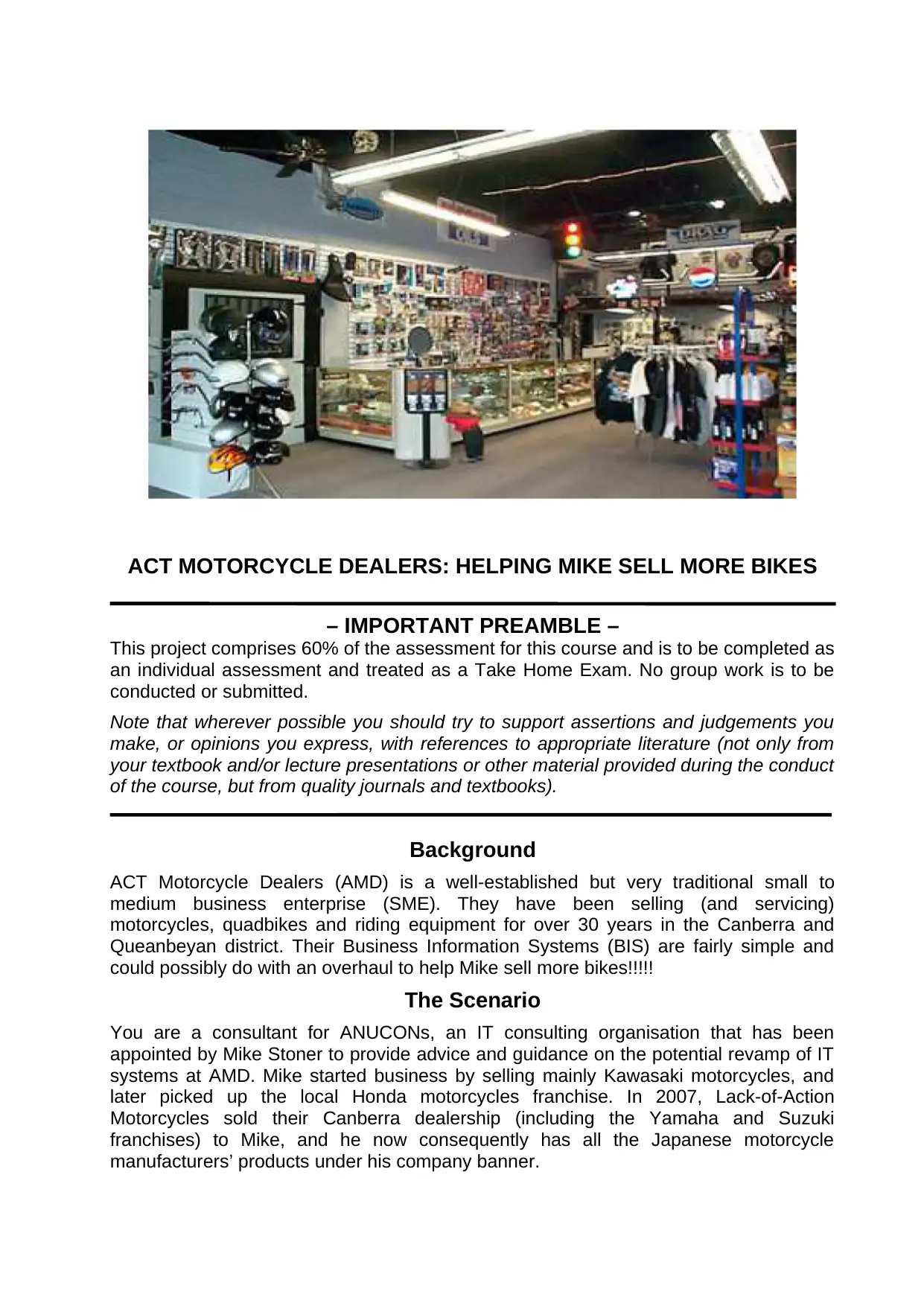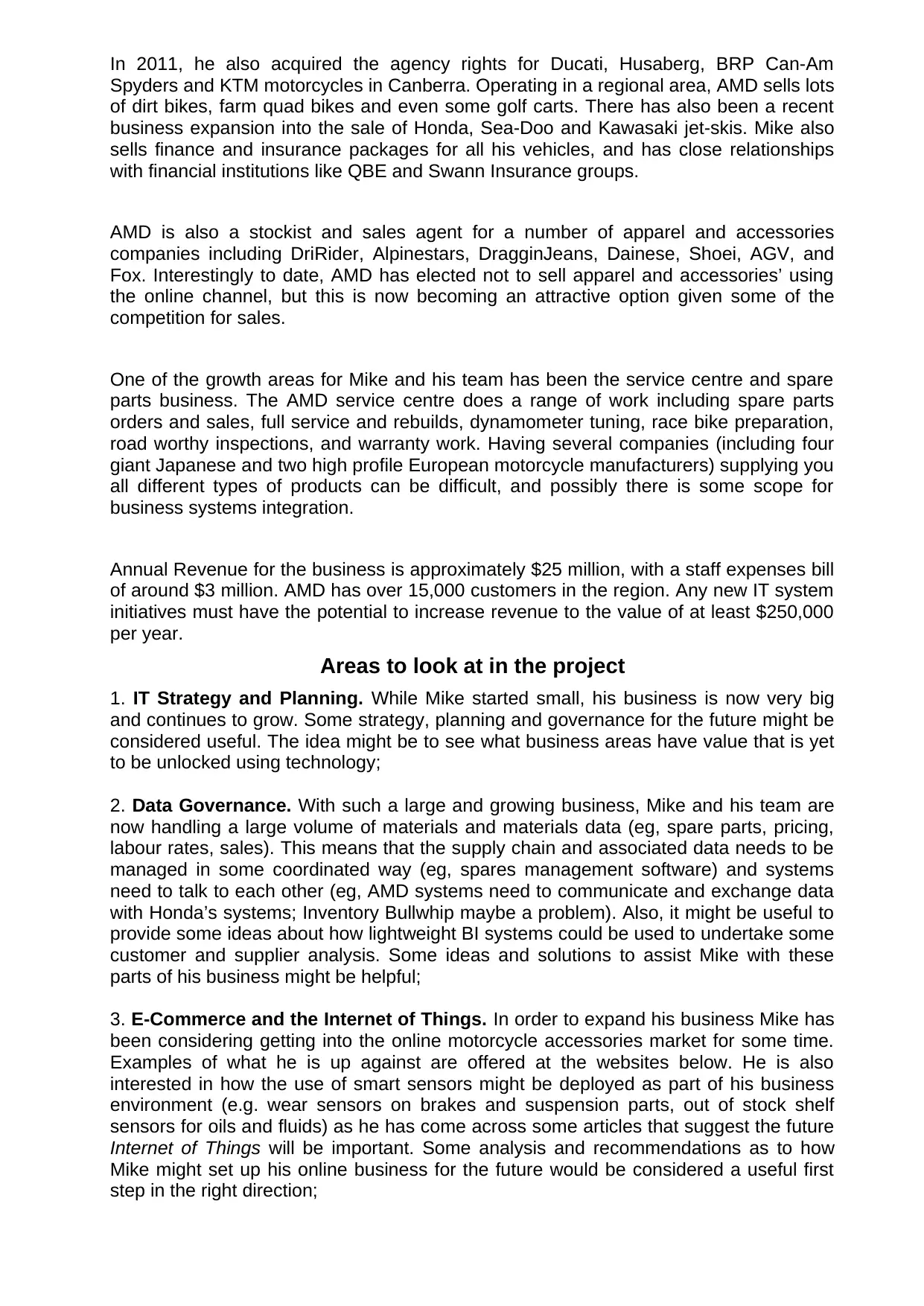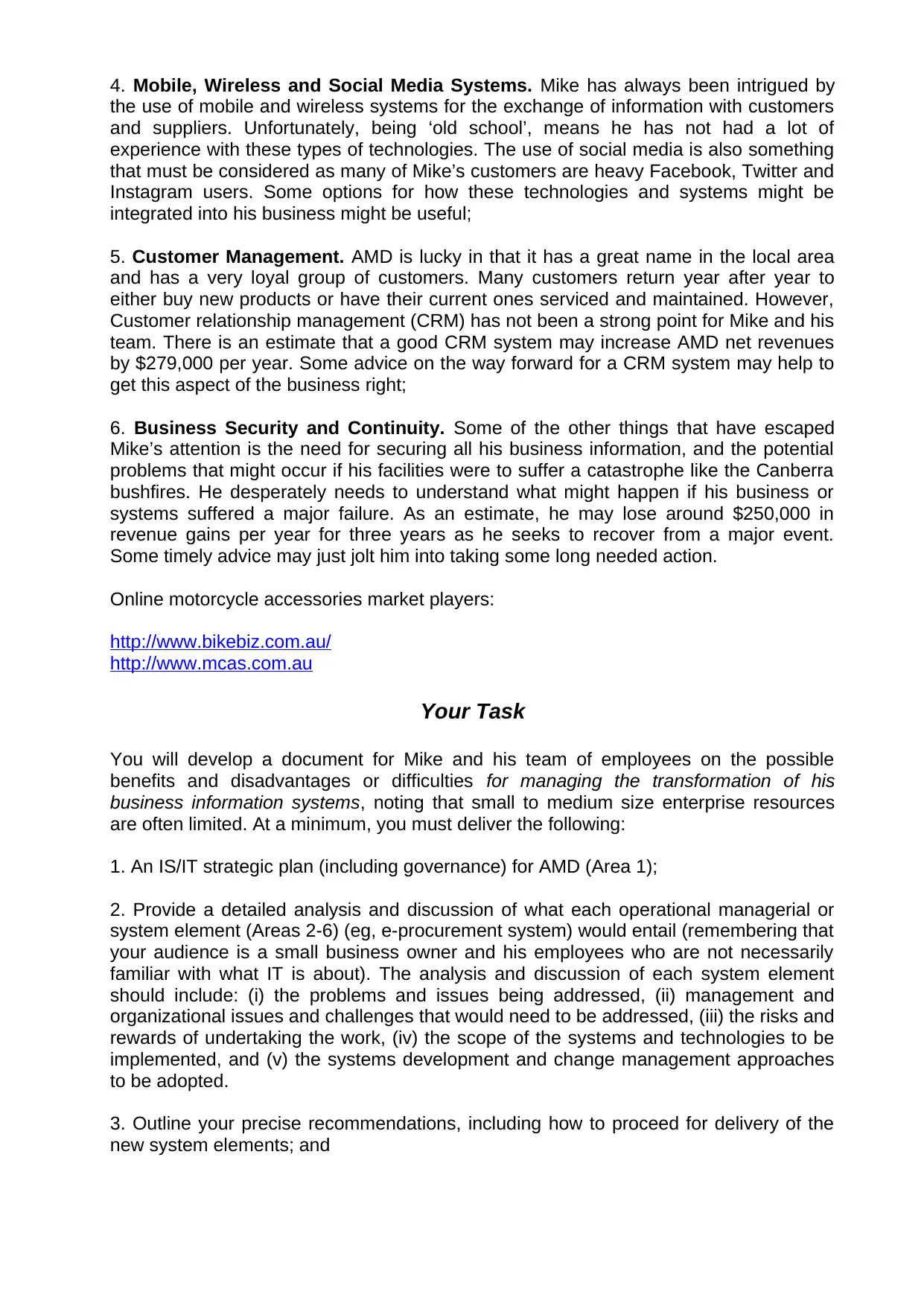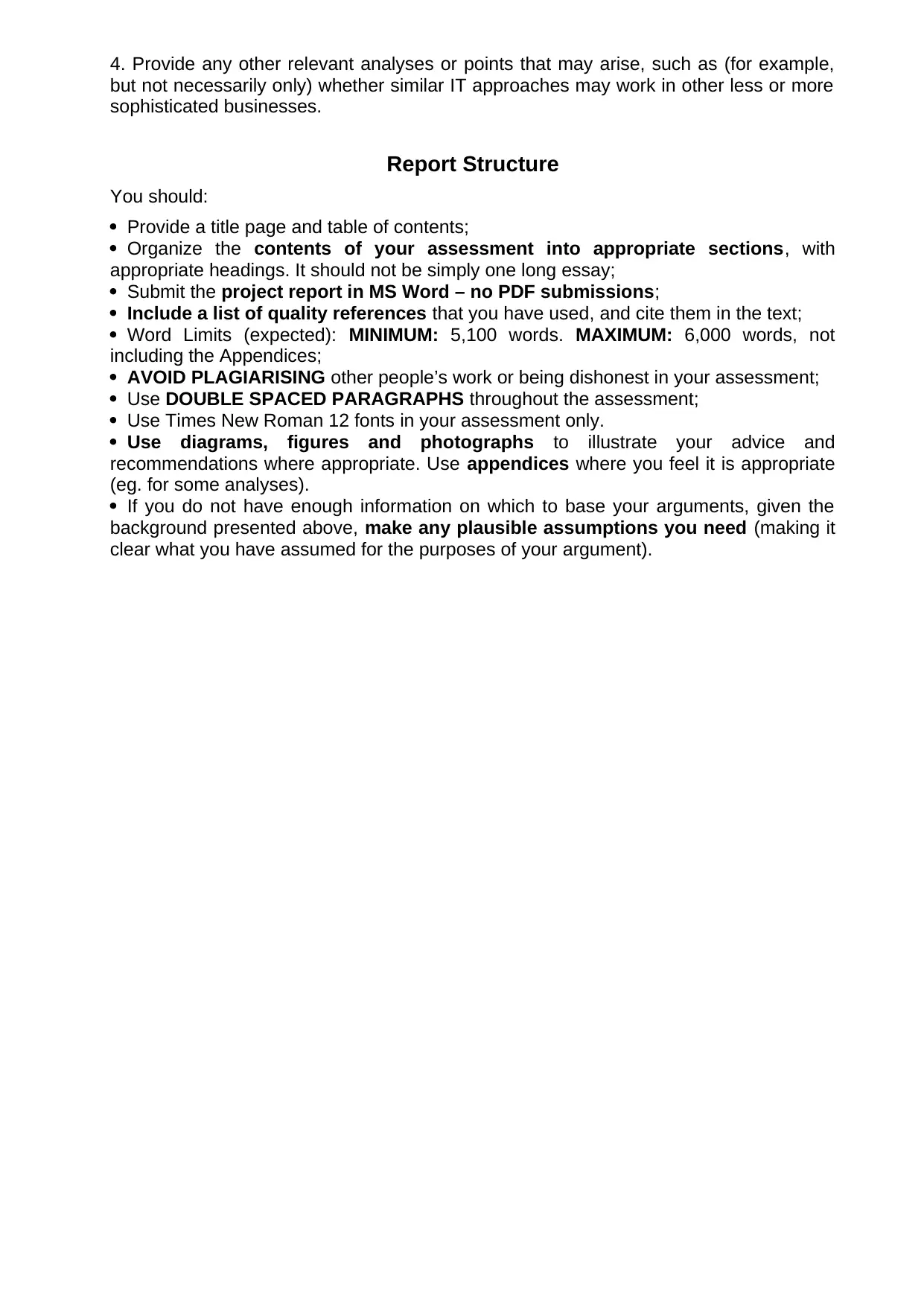ANUCONs Project: ACT Motorcycle Dealers IT Strategy and Plan
VerifiedAdded on 2019/10/09
|4
|1712
|289
Project
AI Summary
This project is a comprehensive analysis and strategic plan for ACT Motorcycle Dealers (AMD), an established SME in the motorcycle and related products industry. The project, undertaken by ANUCONs, addresses the need for a revamp of AMD's Business Information Systems (BIS) to enhance sales and operational efficiency. It covers six key areas: IT strategy and planning, data governance, e-commerce and the Internet of Things, mobile and social media systems, customer management, and business security and continuity. The project involves developing an IS/IT strategic plan, providing detailed analyses of each system element, outlining recommendations for implementation, and considering the challenges and opportunities specific to AMD's business context. The goal is to provide AMD with actionable insights and a roadmap for leveraging technology to increase revenue, improve customer relationships, and ensure business resilience, considering the limitations of a small to medium-sized enterprise. The project emphasizes the importance of aligning IT initiatives with AMD's business goals and addressing the specific needs of the motorcycle dealership, including e-commerce, data management, and customer relationship management.

ACT MOTORCYCLE DEALERS: HELPING MIKE SELL MORE BIKES
– IMPORTANT PREAMBLE –
This project comprises 60% of the assessment for this course and is to be completed as
an individual assessment and treated as a Take Home Exam. No group work is to be
conducted or submitted.
Note that wherever possible you should try to support assertions and judgements you
make, or opinions you express, with references to appropriate literature (not only from
your textbook and/or lecture presentations or other material provided during the conduct
of the course, but from quality journals and textbooks).
Background
ACT Motorcycle Dealers (AMD) is a well-established but very traditional small to
medium business enterprise (SME). They have been selling (and servicing)
motorcycles, quadbikes and riding equipment for over 30 years in the Canberra and
Queanbeyan district. Their Business Information Systems (BIS) are fairly simple and
could possibly do with an overhaul to help Mike sell more bikes!!!!!
The Scenario
You are a consultant for ANUCONs, an IT consulting organisation that has been
appointed by Mike Stoner to provide advice and guidance on the potential revamp of IT
systems at AMD. Mike started business by selling mainly Kawasaki motorcycles, and
later picked up the local Honda motorcycles franchise. In 2007, Lack-of-Action
Motorcycles sold their Canberra dealership (including the Yamaha and Suzuki
franchises) to Mike, and he now consequently has all the Japanese motorcycle
manufacturers’ products under his company banner.
– IMPORTANT PREAMBLE –
This project comprises 60% of the assessment for this course and is to be completed as
an individual assessment and treated as a Take Home Exam. No group work is to be
conducted or submitted.
Note that wherever possible you should try to support assertions and judgements you
make, or opinions you express, with references to appropriate literature (not only from
your textbook and/or lecture presentations or other material provided during the conduct
of the course, but from quality journals and textbooks).
Background
ACT Motorcycle Dealers (AMD) is a well-established but very traditional small to
medium business enterprise (SME). They have been selling (and servicing)
motorcycles, quadbikes and riding equipment for over 30 years in the Canberra and
Queanbeyan district. Their Business Information Systems (BIS) are fairly simple and
could possibly do with an overhaul to help Mike sell more bikes!!!!!
The Scenario
You are a consultant for ANUCONs, an IT consulting organisation that has been
appointed by Mike Stoner to provide advice and guidance on the potential revamp of IT
systems at AMD. Mike started business by selling mainly Kawasaki motorcycles, and
later picked up the local Honda motorcycles franchise. In 2007, Lack-of-Action
Motorcycles sold their Canberra dealership (including the Yamaha and Suzuki
franchises) to Mike, and he now consequently has all the Japanese motorcycle
manufacturers’ products under his company banner.
Paraphrase This Document
Need a fresh take? Get an instant paraphrase of this document with our AI Paraphraser

In 2011, he also acquired the agency rights for Ducati, Husaberg, BRP Can-Am
Spyders and KTM motorcycles in Canberra. Operating in a regional area, AMD sells lots
of dirt bikes, farm quad bikes and even some golf carts. There has also been a recent
business expansion into the sale of Honda, Sea-Doo and Kawasaki jet-skis. Mike also
sells finance and insurance packages for all his vehicles, and has close relationships
with financial institutions like QBE and Swann Insurance groups.
AMD is also a stockist and sales agent for a number of apparel and accessories
companies including DriRider, Alpinestars, DragginJeans, Dainese, Shoei, AGV, and
Fox. Interestingly to date, AMD has elected not to sell apparel and accessories’ using
the online channel, but this is now becoming an attractive option given some of the
competition for sales.
One of the growth areas for Mike and his team has been the service centre and spare
parts business. The AMD service centre does a range of work including spare parts
orders and sales, full service and rebuilds, dynamometer tuning, race bike preparation,
road worthy inspections, and warranty work. Having several companies (including four
giant Japanese and two high profile European motorcycle manufacturers) supplying you
all different types of products can be difficult, and possibly there is some scope for
business systems integration.
Annual Revenue for the business is approximately $25 million, with a staff expenses bill
of around $3 million. AMD has over 15,000 customers in the region. Any new IT system
initiatives must have the potential to increase revenue to the value of at least $250,000
per year.
Areas to look at in the project
1. IT Strategy and Planning. While Mike started small, his business is now very big
and continues to grow. Some strategy, planning and governance for the future might be
considered useful. The idea might be to see what business areas have value that is yet
to be unlocked using technology;
2. Data Governance. With such a large and growing business, Mike and his team are
now handling a large volume of materials and materials data (eg, spare parts, pricing,
labour rates, sales). This means that the supply chain and associated data needs to be
managed in some coordinated way (eg, spares management software) and systems
need to talk to each other (eg, AMD systems need to communicate and exchange data
with Honda’s systems; Inventory Bullwhip maybe a problem). Also, it might be useful to
provide some ideas about how lightweight BI systems could be used to undertake some
customer and supplier analysis. Some ideas and solutions to assist Mike with these
parts of his business might be helpful;
3. E-Commerce and the Internet of Things. In order to expand his business Mike has
been considering getting into the online motorcycle accessories market for some time.
Examples of what he is up against are offered at the websites below. He is also
interested in how the use of smart sensors might be deployed as part of his business
environment (e.g. wear sensors on brakes and suspension parts, out of stock shelf
sensors for oils and fluids) as he has come across some articles that suggest the future
Internet of Things will be important. Some analysis and recommendations as to how
Mike might set up his online business for the future would be considered a useful first
step in the right direction;
Spyders and KTM motorcycles in Canberra. Operating in a regional area, AMD sells lots
of dirt bikes, farm quad bikes and even some golf carts. There has also been a recent
business expansion into the sale of Honda, Sea-Doo and Kawasaki jet-skis. Mike also
sells finance and insurance packages for all his vehicles, and has close relationships
with financial institutions like QBE and Swann Insurance groups.
AMD is also a stockist and sales agent for a number of apparel and accessories
companies including DriRider, Alpinestars, DragginJeans, Dainese, Shoei, AGV, and
Fox. Interestingly to date, AMD has elected not to sell apparel and accessories’ using
the online channel, but this is now becoming an attractive option given some of the
competition for sales.
One of the growth areas for Mike and his team has been the service centre and spare
parts business. The AMD service centre does a range of work including spare parts
orders and sales, full service and rebuilds, dynamometer tuning, race bike preparation,
road worthy inspections, and warranty work. Having several companies (including four
giant Japanese and two high profile European motorcycle manufacturers) supplying you
all different types of products can be difficult, and possibly there is some scope for
business systems integration.
Annual Revenue for the business is approximately $25 million, with a staff expenses bill
of around $3 million. AMD has over 15,000 customers in the region. Any new IT system
initiatives must have the potential to increase revenue to the value of at least $250,000
per year.
Areas to look at in the project
1. IT Strategy and Planning. While Mike started small, his business is now very big
and continues to grow. Some strategy, planning and governance for the future might be
considered useful. The idea might be to see what business areas have value that is yet
to be unlocked using technology;
2. Data Governance. With such a large and growing business, Mike and his team are
now handling a large volume of materials and materials data (eg, spare parts, pricing,
labour rates, sales). This means that the supply chain and associated data needs to be
managed in some coordinated way (eg, spares management software) and systems
need to talk to each other (eg, AMD systems need to communicate and exchange data
with Honda’s systems; Inventory Bullwhip maybe a problem). Also, it might be useful to
provide some ideas about how lightweight BI systems could be used to undertake some
customer and supplier analysis. Some ideas and solutions to assist Mike with these
parts of his business might be helpful;
3. E-Commerce and the Internet of Things. In order to expand his business Mike has
been considering getting into the online motorcycle accessories market for some time.
Examples of what he is up against are offered at the websites below. He is also
interested in how the use of smart sensors might be deployed as part of his business
environment (e.g. wear sensors on brakes and suspension parts, out of stock shelf
sensors for oils and fluids) as he has come across some articles that suggest the future
Internet of Things will be important. Some analysis and recommendations as to how
Mike might set up his online business for the future would be considered a useful first
step in the right direction;

4. Mobile, Wireless and Social Media Systems. Mike has always been intrigued by
the use of mobile and wireless systems for the exchange of information with customers
and suppliers. Unfortunately, being ‘old school’, means he has not had a lot of
experience with these types of technologies. The use of social media is also something
that must be considered as many of Mike’s customers are heavy Facebook, Twitter and
Instagram users. Some options for how these technologies and systems might be
integrated into his business might be useful;
5. Customer Management. AMD is lucky in that it has a great name in the local area
and has a very loyal group of customers. Many customers return year after year to
either buy new products or have their current ones serviced and maintained. However,
Customer relationship management (CRM) has not been a strong point for Mike and his
team. There is an estimate that a good CRM system may increase AMD net revenues
by $279,000 per year. Some advice on the way forward for a CRM system may help to
get this aspect of the business right;
6. Business Security and Continuity. Some of the other things that have escaped
Mike’s attention is the need for securing all his business information, and the potential
problems that might occur if his facilities were to suffer a catastrophe like the Canberra
bushfires. He desperately needs to understand what might happen if his business or
systems suffered a major failure. As an estimate, he may lose around $250,000 in
revenue gains per year for three years as he seeks to recover from a major event.
Some timely advice may just jolt him into taking some long needed action.
Online motorcycle accessories market players:
http://www.bikebiz.com.au/
http://www.mcas.com.au
Your Task
You will develop a document for Mike and his team of employees on the possible
benefits and disadvantages or difficulties for managing the transformation of his
business information systems, noting that small to medium size enterprise resources
are often limited. At a minimum, you must deliver the following:
1. An IS/IT strategic plan (including governance) for AMD (Area 1);
2. Provide a detailed analysis and discussion of what each operational managerial or
system element (Areas 2-6) (eg, e-procurement system) would entail (remembering that
your audience is a small business owner and his employees who are not necessarily
familiar with what IT is about). The analysis and discussion of each system element
should include: (i) the problems and issues being addressed, (ii) management and
organizational issues and challenges that would need to be addressed, (iii) the risks and
rewards of undertaking the work, (iv) the scope of the systems and technologies to be
implemented, and (v) the systems development and change management approaches
to be adopted.
3. Outline your precise recommendations, including how to proceed for delivery of the
new system elements; and
the use of mobile and wireless systems for the exchange of information with customers
and suppliers. Unfortunately, being ‘old school’, means he has not had a lot of
experience with these types of technologies. The use of social media is also something
that must be considered as many of Mike’s customers are heavy Facebook, Twitter and
Instagram users. Some options for how these technologies and systems might be
integrated into his business might be useful;
5. Customer Management. AMD is lucky in that it has a great name in the local area
and has a very loyal group of customers. Many customers return year after year to
either buy new products or have their current ones serviced and maintained. However,
Customer relationship management (CRM) has not been a strong point for Mike and his
team. There is an estimate that a good CRM system may increase AMD net revenues
by $279,000 per year. Some advice on the way forward for a CRM system may help to
get this aspect of the business right;
6. Business Security and Continuity. Some of the other things that have escaped
Mike’s attention is the need for securing all his business information, and the potential
problems that might occur if his facilities were to suffer a catastrophe like the Canberra
bushfires. He desperately needs to understand what might happen if his business or
systems suffered a major failure. As an estimate, he may lose around $250,000 in
revenue gains per year for three years as he seeks to recover from a major event.
Some timely advice may just jolt him into taking some long needed action.
Online motorcycle accessories market players:
http://www.bikebiz.com.au/
http://www.mcas.com.au
Your Task
You will develop a document for Mike and his team of employees on the possible
benefits and disadvantages or difficulties for managing the transformation of his
business information systems, noting that small to medium size enterprise resources
are often limited. At a minimum, you must deliver the following:
1. An IS/IT strategic plan (including governance) for AMD (Area 1);
2. Provide a detailed analysis and discussion of what each operational managerial or
system element (Areas 2-6) (eg, e-procurement system) would entail (remembering that
your audience is a small business owner and his employees who are not necessarily
familiar with what IT is about). The analysis and discussion of each system element
should include: (i) the problems and issues being addressed, (ii) management and
organizational issues and challenges that would need to be addressed, (iii) the risks and
rewards of undertaking the work, (iv) the scope of the systems and technologies to be
implemented, and (v) the systems development and change management approaches
to be adopted.
3. Outline your precise recommendations, including how to proceed for delivery of the
new system elements; and
⊘ This is a preview!⊘
Do you want full access?
Subscribe today to unlock all pages.

Trusted by 1+ million students worldwide

4. Provide any other relevant analyses or points that may arise, such as (for example,
but not necessarily only) whether similar IT approaches may work in other less or more
sophisticated businesses.
Report Structure
You should:
Provide a title page and table of contents;
Organize the contents of your assessment into appropriate sections, with
appropriate headings. It should not be simply one long essay;
Submit the project report in MS Word – no PDF submissions;
Include a list of quality references that you have used, and cite them in the text;
Word Limits (expected): MINIMUM: 5,100 words. MAXIMUM: 6,000 words, not
including the Appendices;
AVOID PLAGIARISING other people’s work or being dishonest in your assessment;
Use DOUBLE SPACED PARAGRAPHS throughout the assessment;
Use Times New Roman 12 fonts in your assessment only.
Use diagrams, figures and photographs to illustrate your advice and
recommendations where appropriate. Use appendices where you feel it is appropriate
(eg. for some analyses).
If you do not have enough information on which to base your arguments, given the
background presented above, make any plausible assumptions you need (making it
clear what you have assumed for the purposes of your argument).
but not necessarily only) whether similar IT approaches may work in other less or more
sophisticated businesses.
Report Structure
You should:
Provide a title page and table of contents;
Organize the contents of your assessment into appropriate sections, with
appropriate headings. It should not be simply one long essay;
Submit the project report in MS Word – no PDF submissions;
Include a list of quality references that you have used, and cite them in the text;
Word Limits (expected): MINIMUM: 5,100 words. MAXIMUM: 6,000 words, not
including the Appendices;
AVOID PLAGIARISING other people’s work or being dishonest in your assessment;
Use DOUBLE SPACED PARAGRAPHS throughout the assessment;
Use Times New Roman 12 fonts in your assessment only.
Use diagrams, figures and photographs to illustrate your advice and
recommendations where appropriate. Use appendices where you feel it is appropriate
(eg. for some analyses).
If you do not have enough information on which to base your arguments, given the
background presented above, make any plausible assumptions you need (making it
clear what you have assumed for the purposes of your argument).
1 out of 4
Related Documents
Your All-in-One AI-Powered Toolkit for Academic Success.
+13062052269
info@desklib.com
Available 24*7 on WhatsApp / Email
![[object Object]](/_next/static/media/star-bottom.7253800d.svg)
Unlock your academic potential
Copyright © 2020–2025 A2Z Services. All Rights Reserved. Developed and managed by ZUCOL.
